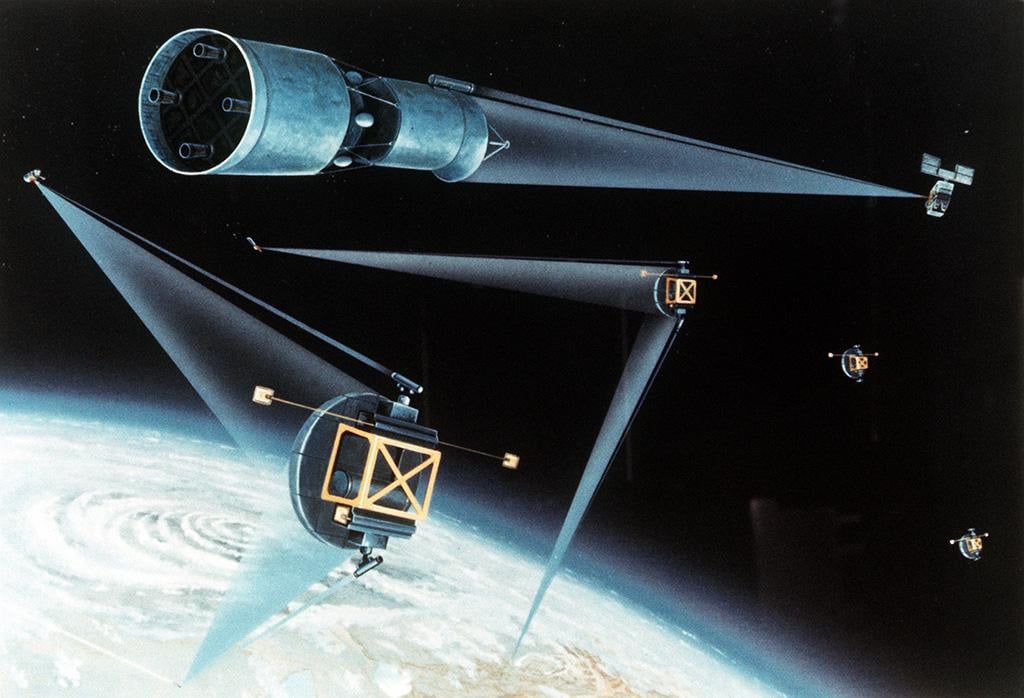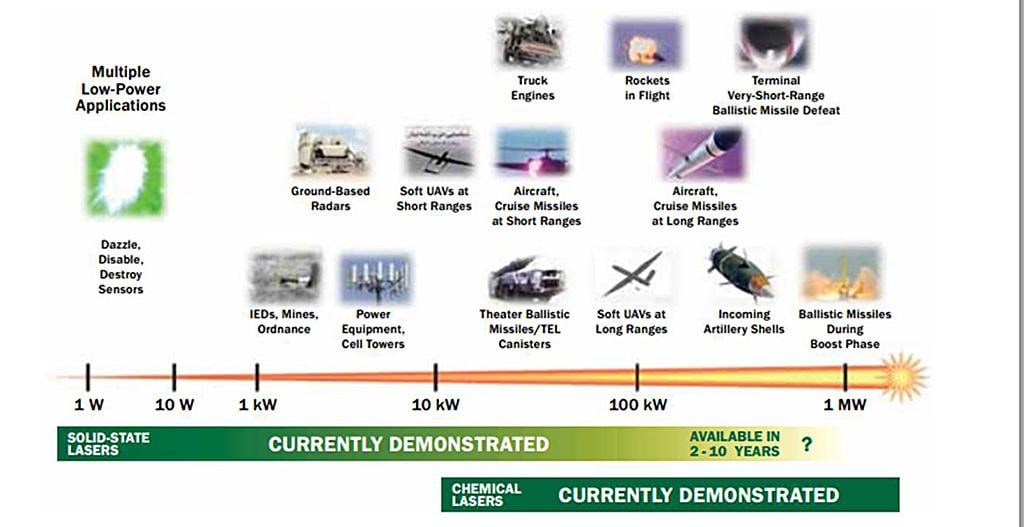Directed-Energy Weapons: No Longer Science Fiction
August 10, 2015
The Greek mathematician and scientist Archimedes is credited with inventing the first directed-energy (DE) weapon during the siege of Syracuse in 214-212 B.C. Writing four centuries later, the Roman author Lucian recorded Archimedes’s use of mirrors to focus sunlight on to invaders’ ships and set them on fire, although modern experimenters have failed to reproduce the weapon. H.G. Wells reintroduced the idea to the popular imagination in 1897 in The War of the Worlds, where the Martian invaders’ heat ray can destroy an armored warship. Even today, the chances of doing that are a million to one.

A team at Hughes Research Laboratories (now HRL Laboratories) created the first laser in 1960, and only seven years later, defense engineers developed the first laser with the power to be used as a weapon. After surface-to-air demonstrations in 1973, the U.S. Air Force modified an NKC-135A as the Airborne Laser Laboratory with a carbon-dioxide laser. It successfully shot down missiles and a UAV in 1983.

In the late 1970s, some U.S. military intelligence experts became convinced that the Soviet Union was well on the way to developing space-based lasers and other DE weapons to destroy U.S. strategic missiles. Alarmist stories appeared in Aviation Week & Space Technology and elsewhere, and in 1983 the Reagan administration launched the Strategic Defense Initiative (SDI)—which initially focused on spaceborne lasers. But the scheme quickly proved impractical: even if the weapons could have been made to work, it would have required a huge constellation of satellites to cover targets at all times.

One SDI program that survived the end of the Cold War was the Airborne Laser (ABL), aimed primarily against the tactical ballistic missile threat that had proven hard to defeat in the first Gulf War, in 1991. Boeing and TRW (now part of Northrop Grumman) were awarded a contract in late 1996 to integrate and test a chemical-oxygen-iodine laser (COIL) on a Boeing 747. The megawatt-class weapon used a flexible mirror to compensate for atmospheric distortion. After $5 billion had been spent, the YAL-1A shot down missile targets in 2010, but the weapon was judged impractical and unaffordable and was canceled in 2011.

U.S. Army
Similar high-powered lasers have been test-fired from the ground at White Sands Missile Range in New Mexico, but (like the lasers on the NKC-135A and YAL-1A) they are chemical lasers in which the “lasing medium”—the material where photons are generated—and the fuel that produces energy are combined and consumed as the weapon is fired. High-power chemical lasers are not only large but need large supplies of fuel, often toxic or otherwise hazardous.

Running from 2002-10, Boeing’s Airborne Tactical Laser (ATL) project involved a COIL installation on a Lockheed Martin C-130. One reference mission was the ability to disable a ground vehicle without any collateral damage. The ATL was much heavier than expected—the C-130 needed a waiver on normal takeoff weight limits—and never demonstrated more than a six-shot-per-mission capability.

Boeing proposed this laser system in 2006 as a potential defense against man-portable air defense systems (Manpads) and as an alternative to placing jamming systems on aircraft.

The U.S. Army/Boeing High-Energy Laser-Mobile Demonstrator (HEL-MD), tested in 2013-14, represents the newer approach to lasers. The laser source itself is a 10-kW fiber laser, based on the kind used for cutting and welding in industry, so the system is energized by a diesel generator.

The U.S. Navy’s 30-kW Laser Weapon System (LaWS) is being tested in the Persian Gulf and off East Africa aboard the USS Ponce. It can disable unmanned air vehicles and small boats, according to the Navy, and has proven reliable since it was deployed in September 2014.

General Atomics–Aeronautical Systems Inc. claims to have achieved a breakthrough in weight, power and beam quality in its “third-generation” laser weapon, now under test. Although this concept represents an older design, the goal is still a 3,000-3,500-lb. system that can be carried on the Avenger unmanned air vehicle and deliver 10 150-kW shots between 3-min. recharges.

The laser power needed to destroy or damage targets depends on range and beam quality—basically, the ability to maintain tight focus on the target—but this chart indicates how many military opportunities open up in the fractional-megawatt range.

The electromagnetic railgun is not a DE weapon and does not achieve light-speed effects, but it can be used at targets over the horizon. U.S. Navy railgun enthusiasts see it as a way to create a warship without gunpowder while extending the vessel’s weapon range. The flame visible in this ground-based test is high-temperature air plasma, not a chemical explosion.

A General Atomics prototype railgun. The projectile exits on the right and the power feeds to the linear accelerator rails are on the left. In the background is the capacitor bank that energizes multijoule shots.

The hypersonic railgun projectile is pushed down the barrel by a metal slug or armature (left) driven by electromagnetic forces between the power rails. A sabot—seen here in the process of separating—holds the conical “bullet” in place. Muzzle velocities of 7,000 fps.—30% faster than any gun—are possible because force is applied constantly along the rails rather than peaking on ignition.

High-power microwave (HPM) weapons are an area of largely classified development. In 2006, however, Raytheon promoted an HPM weapon called Vigilant Eagle for Manpads defense and said it had successfully disabled missiles with experimental HPMs.
Lasers, other directed-energy weapons and electromagnetic railguns have been science-fiction staples for more than a century and teasingly remote fact for decades. Their history has been one of disappointment, failure and expensive programs that never got anywhere near the front line. Today, however, it seems that military needs are becoming more realistic and technology is steadily improving—with effects that might well be revolutionary.